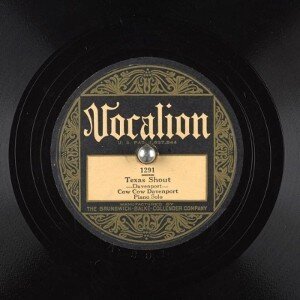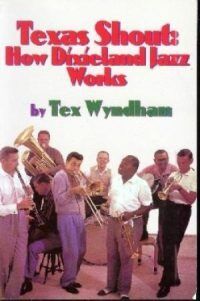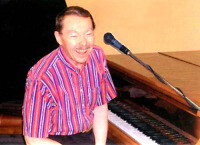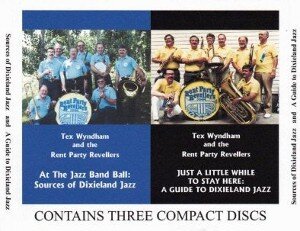 Set forth below is the forty-first “Texas Shout” column. It first appeared in the June 1993 issue of the West Coast Rag, now known as The Syncopated Times. The text has not been updated. The Robert Shaw performances referred to herein have since been reissued in compact disc format on Arhoolie CD 377 “The Ma Grinder.” The great jazz/Blues pianist Art Hodes, to my sorrow, has passed to his reward. Johnny Parth no longer controls the RST label.
Set forth below is the forty-first “Texas Shout” column. It first appeared in the June 1993 issue of the West Coast Rag, now known as The Syncopated Times. The text has not been updated. The Robert Shaw performances referred to herein have since been reissued in compact disc format on Arhoolie CD 377 “The Ma Grinder.” The great jazz/Blues pianist Art Hodes, to my sorrow, has passed to his reward. Johnny Parth no longer controls the RST label.
The original essay closed with (1) a short discussion of Blues periodicals and other references and (2) a review of a then-new album by Washington D.C.’s Sunshine Skiffle Band. Because the data then given with respect to the references are now out of date, and because I see no point in discussing at length an album issued in 1993, most of this material has been tacitly deleted from this reprint.
Dixieland jazz drew many elements from various types of music that preceded it. Even if you choose to limit your listening to Dixieland alone, you will inevitably find yourself rubbing elbows with several of these non-jazz musics, such as brass band marches or Latin-rhythmed compositions.
The non-jazz music most frequently encountered by Dixielanders is, of course, ragtime. Ragtime is a regular part of the presentation of many Dixieland bands. Also, ragtime piano sets are commonly included on the bill at Dixieland festivals.
Next on the list, for those who continue to dig deeply into Dixieland, is Blues. Because this term has at least three meanings in the musical community, let’s begin by defining what’s meant by “blues” for purposes of today’s column.
The first meaning of “blues” refers to a musical selection or performance that conveys a feeling of melancholy, regret, longing or similar emotion to the listener. Hearing it, you might say that the performer “has the blues” and, indeed, you might be moved some way toward that position yourself if the rendition is sufficiently convincing.
The second meaning of “blues” describes a tune which has a certain type of musical structure. Typically, that structure is a variation on a three-phrase, twelve-bar chorus (if played in double time, twenty-four bars).
However, eight-bar blues are quite common (the refrain to “Trouble In Mind” being a familiar example), as are sixteen-bar blues (often built like the chorus to “How Come You Do Me Like You Do” or to “I Wish I Could Shimmy Like My Sister Kate.”) A sixteen-bar blues may have a few extra bars added to its final phrase (called a “turnaround” or “sweet mama” ending), “Sister Kate” again providing a common example thereof.
Among Blues aficionados, longer works, even when bluesy in feeling and performed by acknowledged Blues performers, are not conventionally thought of as blues. Thirty-two-bar numbers, though often found in the repertoire, tend to be regarded instead as pop songs.
When this second meaning is used, the performance need not create a blue mood. The boisterous set-closer “Weary Blues,” for example, or the bouncy “Canal Street Blues,” qualify as blues because they are constructed according to the conventions of blues composing.
Today’s column focuses on the third meaning of “blues,” i.e., as a term that refers to a specific musical genre just as “Dixieland” refers to jazz using a pre-swing jazz musical vocabulary. We’re talking about the music you will find if you enter your local record store and browse through the section labelled “Blues.” For ease in understanding, when I use the word herein with this third meaning, I will write it “Blues,” with its first letter capitalized.
The Blues section will include two rather different-sounding types of music. One is referred to as “acoustic,” “pre-war,” or “country” Blues, while the other is, naturally, “electric,” “post-war,” or “urban” Blues.
Country Blues is typically heard on unelectrified instruments, played by a solo guitar/vocalist or at most two or three people (the additional instruments being, perhaps, piano, violin, or harmonica – called a “mouth harp” or “harp” by Blues fans). Urban Blues is often performed on electric instruments by a Blues band, consisting of some combination of vocal, lead guitar, rhythm guitar, keyboard, harp, bass and drums. Urban Blues did not really come into its own until just after World War II, which explains the aforementioned “pre-war” and “post-war” labels.
Blues is primarily a vocal idiom. There are instrumental Blues rides, of course, but the overwhelming bulk of Blues recordings are vocal.
Thus, to appreciate Blues fully, one must be willing to pay attention to the lyrics along with the musical setting therefor as well as the vocalist’s timbre and skill at conveying his/her message. As with any musical performance, the success thereof is judged by whether those elements do or do not come together to create a unified, valid visualization of the material that strikes a strong emotional response in the listener.
As I said, the dedicated Dixielander, as he/she becomes more of a completist, will inevitably be exposed to Blues. Johnny Dodds’ fans will collect his appearances with Blind Blake and the Dixieland Jug Blowers. Ma Rainey buffs will acquire her sides with Tampa Red and Georgia Tom, the Tub Jug Washboard Band, and Papa Charlie Jackson (who also recorded with Freddie Keppard). King Oliver completists will own his accompaniments to Texas Alexander. Louis Armstrong admirers – everyone reading these words – will hear Lonnie Johnson playing with the Hot Five (indeed, Johnson is on 78s with Duke Ellington and Eddie Lang as well). I could go on, but the list is very long, and you take my point.
As I collected Dixieland recordings, I eventually developed a liking for Blues. In fact, in recent years, I’ve probably purchased more Blues LPs and CDs than jazz.
However, it is only very recently that I have made a conscious effort to comprehend Blues and to read works devoted entirely to it. I came to like Blues accidentally, through brute force, because the music kept insistently knocking on my door while I was trying to shut it out and listen to the Dixieland elements of the performances.
Some of you are, I’m sure, traveling that same road and are going to reach the same destination. Thus, I’d like to offer a few tips that may make the journey easier, perhaps hastening the day when you gain the ability to appreciate Blues in more depth.
First of all, don’t start with urban Blues. If you’re coming to it cold, based entirely in Dixieland, an urban Blues band is going to sound too much like rock n’ roll. You will be turned off immediately by its heavy, insistent, riff-based beat. (In fact, the evolution – or deterioration, depending on your taste – of urban Blues into rhythm-and-blues and then into rock n’ roll is quite clear, even to an unsophisticated listener.)
If you absolutely must hear some urban Blues, try starting with Arhoolie CD 305, “Ball N’ Chain,” by Big Mama Thornton, an excellent big-voiced belter evocative in some ways of the immortal Bessie Smith. On six of its sixteen cuts, Ms. Thornton is backed by the most important and influential urban Blues band ever, that of guitarist Muddy Waters, so you will get a fair shot at deciding whether you like the idiom while appreciating a stirring singer.
Personally, I am just beginning to get my arms around urban Blues. I still find much of it rather noisy and monotonous, and am picking my way very carefully through the record racks.
Country Blues will be much more accessible to a Dixielander. I have enjoyed it for at least ten years.
However, it took me longer than it should have to reach this point. That delay occurred because, paradoxically, I was initially exposed to two of the acknowledged greats in the field, Blind Lemon Jefferson and Charlie Patton.
Jefferson’s recordings were included on a couple of LPs in Riverside’s wonderful Jazz Archives reissues from the 1950s and 1960s, a series which I acquired and listened to avidly. While I am now able to comprehend his compelling blend of high-pitched whining vocals and pleading guitar, back then Jefferson was much too different from the Dixieland I was hearing on the other Riverside albums. Moreover, the sides being reissued were somewhat scratchy, making Jefferson’s already slurry diction nearly incomprehensible.
The same thing occurred when I sampled Charlie Patton, considered by some to be the all-time greatest Mississippi Delta Blues singer. His thick dialect, difficult enough on its own, was noticeably immersed in surface noise, causing him to come across as someone mumbling lyrics I couldn’t understand to an accompaniment that seemed relatively unchanging from track to track.
The trick is not to plunge right into Blues, but to begin with artists who work more closely to the jazz-Blues border. That way, you will hear much music to which you can easily relate while you learn to appreciate the newer elements more gradually – without being hit over the head by them.
One way to get there is through the piano. Start, for example, with Art Hodes (my favorite living jazzman) who, though he is first and foremost a jazz player, is one of the bluesiest jazz ticklers you’ll find. Once you’ve picked up on what Hodes is doing, get some of the relatively recent solo or small band sides with the late Sammy Price, much of whose playing is predominantly Blues with a strong jazz element. Or try Eurreal “Little Brother” Montgomery, who could perform equally effectively with Dixieland bands or Blues artists.
Then you’ll be ready for the record that turned the corner for me, “Texas Barrelhouse Piano” by Robert Shaw. (I have it on LP, but Arhoolie must have released this much-praised album on CD by now.) Shaw worked rowdy Texas roadhouses in his youth, retired from music to run a grocery store, becoming sufficiently successful that he was able to maintain a pure barrelhouse Blues style over the years by playing in his living room for his own amusement.
This March 1963 solo session drips with juice, roots, and authenticity that’s only hinted at by the titles of some of his pieces – “Put Me In The Alley,” “The Ma Grinder,” “Whores Is Funky,” and “Here I Come With My Dirty, Dirty Duckins On.” If you can’t appreciate Shaw, you’ll never like Blues piano.
Another avenue to the Blues is through jug bands. Although usually comprised of country Blues performers, they have an easy-rolling loose rhythm which jazz fans will readily grasp, not to mention their infectious don’t-give-a-damn high spirits.
There were three great jug bands in the twenties. Start with the Dixieland Jug Blowers, which used enough “legitimate” instruments that it is listed in jazz discographies. Moreover, you will hear the unbelievable Earl McDonald, to my mind the Louis Armstrong of the jug, who sounds at times like he’s playing a slide tuba! Then you’ll be ready for the next two, the bracing Memphis Jug Band and the most countryish of the trio, Cannon’s Jug Stompers.
The heart and soul of country Blues lies with its singer/guitarists. To sample these, I think it is critical that you start with ones whose lyrics can easily be understood. Try picking up something by Lonnie Johnson, Blind Blake and Papa Charlie Jackson.
Johnson, one of the most prolific Blues artists of all time, had a lovely, clear voice and impeccable diction. He was also a superior guitar player by any standard, his historic duets with the great Eddie Lang being much prized by jazz fans. He retained his skills throughout a long career during which he recorded a wide variety of material, both blues and pops.
Blind Blake’s rich baritone is also a pleasure to hear and easy to grasp, while his guitar playing ranks with that of the best country bluesmen. Jackson’s instrument was the banjo, which made it easier for me as a Dixielander to relate to him, while his material displays a solid streak of the hokum songster tradition, nicely balancing the more traditional blues for someone new to the field.
As I write, a record producer in Austria, Johnny Parth, is in the process of releasing multi-volumed CDs containing, in chronological order, the entire recorded output of many early country Blues artists. Like George Buck, Parth controls several labels, the most common being RST and Document. These labels would be available from blues specialty dealers, such as Down Home Music, Inc., 10341 San Pablo Avenue, El Cerrito, California 95430 and Bob’s Blues and Jazz Mart 3419 W Irving Park Rd, Chicago, IL 60618.
Today’s collectors can eliminate digging and duplication, such as I went through during the LP era, by picking up Parth’s complete chronological sets on the Memphis Jug Band, Gus Cannon and the Jug Stompers, Blind Blake and Papa Charlie Jackson, plus seven volumes of Lonnie Johnson’s earliest sides. A more widely available domestic label, Yazoo, also has sampler CDs containing the best 78s by these artists.
If you want to read further about, and stay current on, this subject, the largest-circulation Blues magazine of interest is probably Living Blues. The principal discography on pre-war Blues, Blues And Gospel Records 1890-1943, by Robert M.W. Dixon, John Godrich & Howard W. Rye, is, at this writing, in its fourth edition. Capsule biographies of a comprehensive list of Blues artists appear in Blues Who’s Who (1979), by Sheldon Harris. If these two books remain in print, they might be obtainable through the mega-bookstores on the Internet.

The full run of “Texas Shout” has been collected into a lavishly illustrated trade paperback entitled Texas Shout: How Dixieland Jazz Works. This book is available @ $20.00 plus $2.95 shipping from Tex Wyndham, On request, Tex will autograph the book and add a personalized note (be sure to tell him to whom the note should be addressed).
Tex Wyndham’s 3 CD Guide to Dixieland with music and commentary is available for $20 plus $2.95 shipping. The separate CD, A History of Ragtime: Tex Wyndham Live At Santa Rosa, is available for $13.00 plus $2.00 shipping. On request, Tex will autograph the inner sleeve and add a personalized note (be sure to tell him to whom the note should be addressed).
Send payment to Tex Wyndham, P.O. Box 831, Mendenhall, PA 19357, Phone (610) 388-6330.
Note: All links, pictures, videos or graphics accompanying the Shouts were added at the discretion of the Syncopated Times editorial staff. They did not accompany the original columns and do not necessarily reflect the opinion of Tex Wyndham.
From roughly 1970-2010, Tex Wyndham was: (1) one of the best-known revivalist Dixieland jazz musicians in the US, as cornetist, pianist and bandleader, (2) one of the best-known ragtime pianists in the US, and (3) one of the most respected critics in the US of Dixieland jazz, ragtime, and related music. He is the only person about whom all three of those statements can be made.




